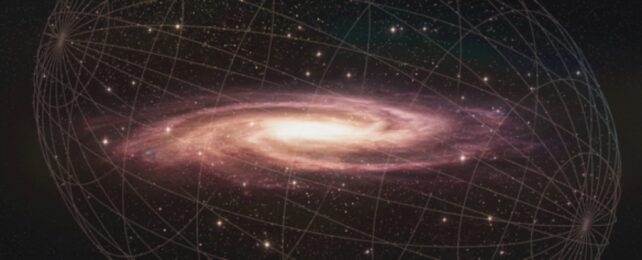A huge invisible mass could be the reason the Milky Way's disk is warped and twisted.
A new study shows that a tilted, misaligned dark halo – the large blob of dark matter that wraps around and permeates our home galaxy – is the only explanation to date that explains all the features of the shape of the Milky Way.
It's nothing to be alarmed about; but it could give us some new information about the evolution of the Milky Way over the course of time, which we're slowly piecing together, clue by clue.
"Here we show that a dark halo tilted in the same direction as the stellar halo can induce a warp and flare in the Galactic disk at the same amplitude and orientation as the data," writes a team led by astrophysicist Jiwon Jesse Han of the Harvard & Smithsonian Center for Astrophysics (CfA).
"These results, in combination with data in the stellar halo, provide compelling evidence that our Galaxy is embedded in a tilted dark matter halo. This misalignment of the dark halo and the disk holds clues to the formation history of the Galaxy and represents the next step in the dynamical modeling of the Galactic potential."
It's difficult to see the shape of a galaxy you happen to be living in. It's not as if we can just send a telescope out into intergalactic space to take a photo. So while astronomers have known for some time that the disk was warped, we didn't have enough data to figure out what was going on.
It wasn't until Gaia, a space telescope mapping the positions and velocities of the stars in the Milky Way with high precision, that astronomers were able to map in detail the wonkiness of the Milky Way.
Around the outskirts of the galaxy, astronomers have found powerful, accumulating evidence of a warp and flare. But it's unclear what could have caused it. The leading explanation is an interaction, either past or ongoing, with another galaxy.
However, none of the explanations proposed to date have explained both the warp and the flare, according to Han and his colleagues, astronomer Charlie Conroy and astrophysicist Lars Henquist, both also of CfA.
Last year, though, a team led by Han and Conroy made an interesting discovery. The halo of stars around the galaxy – the diffuse globe of gas and stars in which the galactic disk revolves – is also off-kilter.
That suggested to the researchers that the Milky Way's dark halo is also highly tilted. That's a globe of dark matter that wraps around most galaxies, an otherwise undetectable mass that gravitationally interacts with normal matter in the Universe.
So they conducted some simulations and modeling to see if they could reproduce the observed shape of the Milky Way, warp, flare, and all.
They created a model of the galaxy in which the dark halo was tilted 25 degrees with respect to the disk of the Milky Way, and calculated the orbits of stars and gas over a period of 5 billion years. They found that, when the blob of dark matter is tilted, the outskirts of the galaxy do indeed warp and flare, exactly as we see in the Gaia observations of the Milky Way.
Now, that's not to say a galactic interaction is not involved. In fact, it's likely, the team says. But their results do suggest that the interaction was past, not ongoing. Their simulation showed that a collision with another galaxy can tilt the dark halo significantly, and that the warp of the galactic disk happens quickly – within one orbit following the dark halo tilt.
Following the event, the dark halo's tilt slowly swings back to normal; in the simulation, after a galactic collision 7 billion years ago, the dark halo of a Milky Way analogue took around 5 billion years to reduce from 50 degrees to 20 degrees.
"This result," the researchers write, "shows that the Milky Way's dark halo was likely more tilted in the past and has decreased to its current value (~25 degrees) at the present day."
The research has been published in Nature Astronomy.
